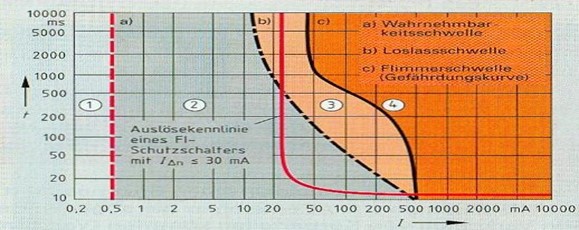Nt Campus
- Home
- No Heartache with TECNATIVES Nt
No Heartache with TECNATIVES Nt

| Area | Physiological Effect |
|---|---|
|
1
|
Perception possible, but generally no shock reaction.
|
|
2
|
Perception and involuntary muscle contraction likely, but generally no adverse physiological effects.
|
|
3
|
Strong involuntary muscle contractions, difficulty breathing, reversible disorders of heart function, immobilization (muscle cramping) may occur. Increasing effect with amperage and duration of flow. In general, no organic damage is to be expected.
|
|
4
|
Pathological effects such as cardiac arrest, respiratory arrest and burns may occur. Probability of ventricular fibrillation increasing with amperage and duration of flow.
|
| Kawasan | Kesan Fisiologi |
|---|---|
|
1
|
Persepsi mungkin, tetapi secara amnya tiada reaksi kejutan.
|
|
2
|
Persepsi dan pengecutan otot secara tidak sengaja mungkin, tetapi secara amnya tiada kesan fisiologi yang buruk.
|
|
3
|
Penguncupan otot sukarela yang kuat, kesukaran bernafas, gangguan fungsi jantung yang boleh diterbalikkan, imobilisasi (kekejangan otot) mungkin berlaku. Meningkatkan kesan dengan amperage dan tempoh aliran. Secara umum, tiada kerosakan organik dijangkakan.
|
|
4
|
Kesan patologi seperti serangan jantung, penangkapan pernafasan dan melecur mungkin berlaku. Kebarangkalian fibrilasi ventrikel meningkat dengan amperage dan tempoh aliran.
|
It is important for users of EMS applications to know that they are using a secure product. In particular, the question of whether EMS can be used to excite the heart muscle moves many people. Some trainers point to the frequencies and say that due to the low frequencies during EMS training (up to max. 120 Hertz) the heart muscle cannot be stimulated. As proof, applications are cited that consciously stimulate the heart (pacemakers, defibrillators), which operate in a much larger frequency range (up to 10,000 Hertz).
However, this reason is wrong, in fact cardiac arrhythmia such as ventricular fibrillation can already be triggered by an alternating current of only 50 Hertz.[1]
The threshold of ventricular fibrillation depends both on physiological influences such as body structure and the state of cardiac function, and on other parameters such as the duration of the flow, the current path and current parameters such as current intensity and voltage. Ventricular fibrillation can occur when the electrical stimulus of the heart takes place during the regression of excitation, the so-called vulnerable phase of the ventricles.[2] However, whether a cardiac arrhythmia actually occurs depends primarily on the current intensity and the duration of the flow. The longer the duration of the flow, the lower the current intensity causing a risk of ventricular fibrillation can be. For example, with a flow duration of 100 milliseconds (0.1 seconds) at approx. 50 mA there is a risk that ventricular fibrillation is triggered, but with a flow duration of 10 milliseconds (0.01 seconds) only currents of approx. 200 mA can trigger cardiac arrhythmia.[3]
“Due to the flow duration and current intensity of the TecNative system, only the skeletal muscles are excited. Disturbances of the heart functions are absolutely unlikely.”
– Judith Münch
Our TecNatives system works with very short flow durations of a maximum of 400 microseconds (0.0004 seconds) and currents of a maximum of 200 mA. The physiologically probable effects in this range are the perception of the current and involuntary muscle contractions (the EMS effect). Difficulties in breathing and cardiac dysfunction are not expected. Pathophysiological effects such as cardiac arrest, respiratory arrest, burns or other cell damage could only be observed in scientific studies with very high current intensities (1000 mA – 10 000 mA) or current intensities above 100 mA with flow durations of 2000 ms (2 s). These high currents and flow durations are far removed from the areas in which the TecNatives system operates.
Furthermore, all these values refer to a current path from the left hand to the feet. This means that the current flows exactly through the heart. With our TecNatives system, however, currents never flow through the heart or torso, but always between the same pairs of electrodes and thus only through the muscle that is to be specifically addressed. For example, current flows between the two breast electrodes through the Musculus pectoralis major, the large pectoral muscle. But the current does not flow from the chest electrode to the back electrode.
Due to the low current intensity (max. 200 mA) and in particular the very short flow duration (max. 400 microseconds) and the current path, which does not pass through the heart muscle, only skeletal muscles are excited by the TecNatives system. The risk of ventricular fibrillation is almost non-existent. However, from a scientific point of view, a danger can never be completely excluded, since there is no “zero” risk in technology. Nevertheless, we can say that if the TecNatives system is used professionally, only the skeletal muscles will be stimulated and cardiac arrhythmias are absolutely unlikely to occur due to the selected and technically fixed parameters.
- 1 RAFTERY, E.B., H.L. GREEN, and M.H. YACOUB, Disturbances of heart rhythm produced by 50 Hz leakage currents in human subjects. Cardiovascular Research, 1975. 9(2): p. 263-265.
- 2 Gonschorek, A. and T. Strecker, Allgemeine Physiologie und Pathophysiologie, in Empfehlungen zum Einsatz und zur Verwendung der Herz-Lungen-Maschine. 2006, Springer. p. 31-44.
- 3 Biegelmeier, G., Kriterien für konventionelle Vereinbarungen über vertretbare Risiken beim Schutz gegen schädlichen elektrischen Schlag bei Wechselstrom 50/60 Hz. e & i Elektrotechnik und Informationstechnik, 2006. 123(12): p. 571-583.
- Image Source Fachkunde Elektrotechnik; 22.Auflage 1999; Europa Verlag
GET IN TOUCH
Write us a short message to receive your desired information. Alternatively, you can contact one of our distributors in your region directly.















